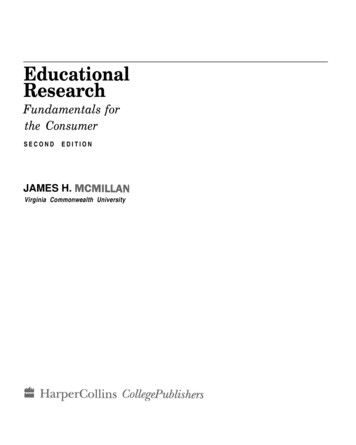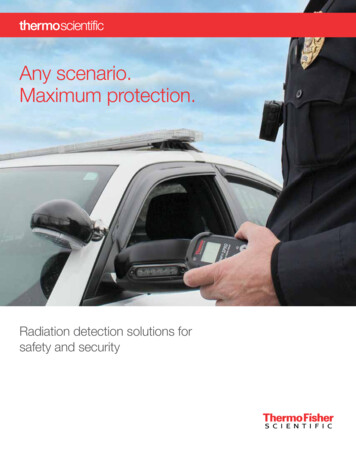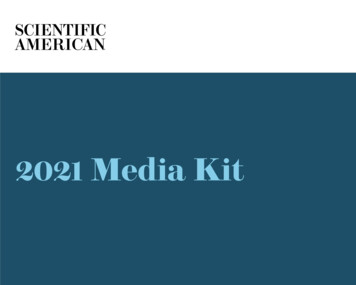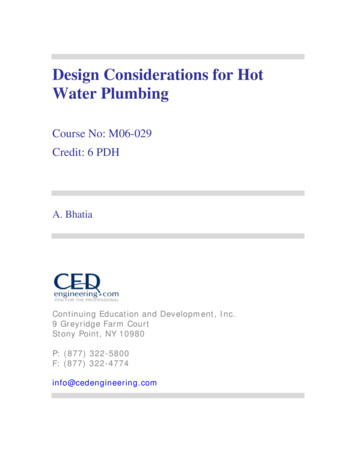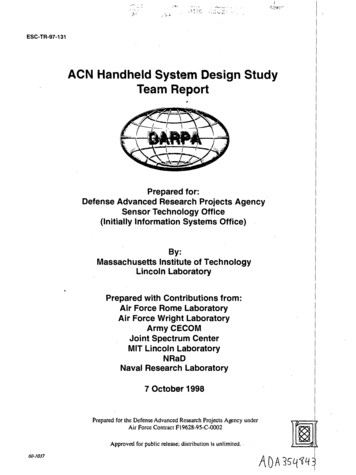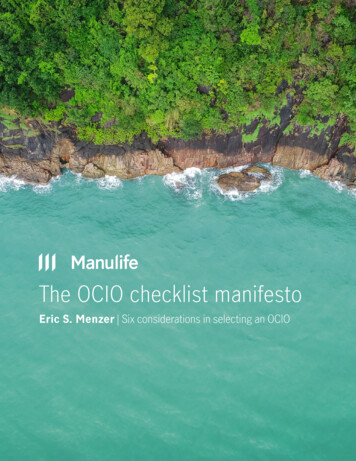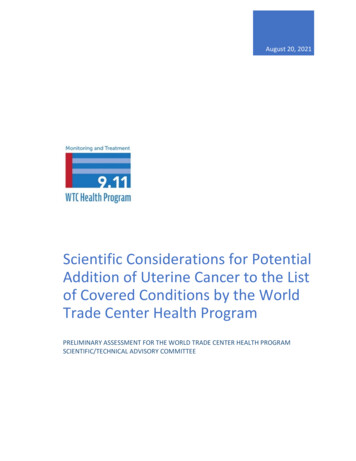
Transcription
August 20, 2021Scientific Considerations for PotentialAddition of Uterine Cancer to the Listof Covered Conditions by the WorldTrade Center Health ProgramPRELIMINARY ASSESSMENT FOR THE WORLD TRADE CENTER HEALTH PROGRAMSCIENTIFIC/TECHNICAL ADVISORY COMMITTEE
Table of contentsI. Executive Summary .2II. Background .3A.Procedures for Adding Cancers for Coverage in the WTC Health Program.3B.Uterine Cancer: Definition, Types, and Risk Factors.4C.Previous Consideration of Uterine Cancer by the WTC Health Program .6III. WTC Health Program Evaluation of Available Evidence Regarding Uterine Cancer Among 9/11 ExposedPopulations.6A.Method 1 – Epidemiologic Studies of September 11, 2001 Exposed Populations.7B.Method 2 – Established Casual Association .14C.Method 3 – Review of Evaluations of Carcinogenicity in Humans .15IV. Additional Considerations .24V. WTC Health Program’s Actions after Receipt of the STAC Recommendation .27VI. References.28Page 1 of 32
I. Executive SummaryThe World Trade Center (WTC) Health Program provides medical monitoring and treatment benefits forhealth conditions on the List of WTC-Related Health Conditions (the List). The List currently includesaerodigestive disorders, mental health conditions, musculoskeletal disorders, and cancers. The List wasestablished in the Zadroga Act and new health conditions may be added to the List by rulemaking. Inaddition to the Program’s regulatory provisions in 42 C.F.R. Part 88, the WTC Health Program Policy andProcedures for Adding Types of Cancer to the List of WTC-Related Health Conditions governs theevaluation of evidence supporting the potential addition of a type of cancer to the List.Uterine cancer is currently the only type of cancer not included in the WTC Health Program’s List ofWTC-Related Conditions. In September 2020, the WTC Health Program received a submission to adduterine cancer to the List. The medical basis for the submission was the contributing role of endocrinedisrupting chemicals (EDCs) on the incidence rate of uterine cancers. Although this submission did notmeet the Program’s petition requirements, the Administrator instructed WTC Health Program staff toreview the evidence for uterine carcinogenicity by EDCs and other 9/11 agents. This document providesthe WTC Health Program’s assessment of the currently available evidence to support adding uterinecancer to the List.In addition to directing the Science Team to assess the available evidence supporting the addition ofuterine cancer to the List, the Administrator is seeking the advice of the Scientific/Technical AdvisoryCommittee (STAC) for a recommendation regarding whether there is a reasonable basis for addinguterine cancer to the List. The STAC is given up to 180 days to provide the recommendation. TheAdministrator will evaluate the STAC’s advice and will take an appropriate action not later than 90 daysafter receipt of the recommendation.Page 2 of 32
II. BackgroundThe WTC Health Program provides medical monitoring and treatment benefits for health conditions onthe List of WTC-Related Health Conditions (List). The List currently includes aerodigestive disorders,mental health conditions, musculoskeletal disorders, and cancers. Currently, uterine cancer is the onlytype of cancer not included on the List.1Uterine cancer is often referred to as endometrial cancer because more than 90 percent of cases occurin the endometrium. Known risk factors for uterine cancer include endometrial hyperplasia, hormonetherapy with estrogen, selective estrogen receptor modulators, and obesity. Protective factors includeincreasing parity (number of pregnancies) and lactation, hormonal contraceptives, physical activity, andsmoking.A subtype of uterine cancer, uterine sarcoma, is covered as a rare cancer –those cancers that have anincidence rate of less than 15 cases per 100,000 per year in the U.S. based on 2005-2009 average annualdata age-adjusted to the 2000 U.S. population.2 In addition, uterine cancers that arise from the use oftamoxifen to treat a WTC-certified cancer may be covered as a medically associated condition (MAC).A. Procedures for Adding Cancers for Coverage in the WTC Health ProgramThe James Zadroga 9/11 Health and Compensation Act of 2010 (Zadroga Act) established the List andpermits the addition of more health conditions through rulemaking. The Zadroga Act provides twopathways to initiate the process of adding a health condition, including types of cancer, to the List: (1)the Administrator of the WTC Health Program initiates the rulemaking process and publishes a proposedrule or requests a recommendation from the STAC at his discretion; or (2) the Administrator initiates theprocess after receiving a petition from an interested party.3In addition to the Program’s regulatory provisions in 42 C.F.R. Part 88, the WTC Health Program Policyand Procedures for Adding Types of Cancer to the List of WTC-Related Health Conditions governs theevaluation of evidence supporting the potential addition of a type of cancer to the List.4 The Policy andProcedures establishes that a review of the evidence must demonstrate fulfillment of at least one offour methods as basis to propose adding a condition to the List:Method 1 – Epidemiologic studies of September 11, 2001 exposed populationsThe WTC Health Program evaluates the “weight of evidence” from peer-reviewed, published,epidemiologic studies of 9/11-exposed populations, by following four following criteria of Bradford Hill’sguidelines for assessing causation:5a. Strength of the association between a 9/11 exposure and a type of cancer (including theprecision of the risk estimate);b. Consistency of the findings across multiple studies;c. Biological gradient, or dose-response relationships between 9/11 exposures and the type ofcancer; andd. Plausibility and coherence with known facts about the biology of the type of cancer.Page 3 of 32
Method 2 – Established casual associationA type of cancer may be added to the List if there is well-established scientific support published inmultiple epidemiologic studies for a causal association between that cancer and a condition already onthe List of WTC-Related Health Conditions.Method 3 – Review of evaluations of carcinogenicity in humansA type of cancer may be added to the List under Method 3 only if both of the following criteria aresatisfied: 3A. Published exposure assessment information. A 9/11 agent included in the Inventory of 9/11Agents is identified;6 and 3B. Evaluation of carcinogenicity in humans from scientific studies. The National ToxicologyProgram (NTP) has determined that the 9/11 agent is known to be a human carcinogen or isreasonably anticipated to be a human carcinogen, and the International Agency for Research onCancer (IARC) has determined there is sufficient or limited evidence that the 9/11 agent causesa type of cancer.Method 4 – Review of information provided by the WTC Health Program Scientific/Technical AdvisoryCommittee (STAC)A type of cancer may be added to the List if the STAC provides a reasonable basis for adding it.B. Uterine Cancer: Definition, Types, and Risk FactorsCancer of the uterine corpus (uterine cancer) is a type of cancer that begins to develop in the uterus.The uterus is the hollow, pear-shaped pelvic organ where a fetus develops. Uterine cancer is oftenreferred to as endometrial cancer because more than 90 percent of cases occur in the endometrium(lining of the uterus); most of the remainder of uterine cancers originate in the myometrial muscle or,less commonly, the endometrial stroma.7, 8Table 1 lists all subtypes of uterine cancer and their codes, according to the International Classificationof Diseases, 10th Edition (ICD-10).9Table 1. Classification of uterine cancers according to the InternationalClassification of Diseases, 10th Edition (ICD-10)ICD-10 CodeNameC54Malignant neoplasm of corpus uteriC54.0Malignant neoplasm of isthmus uteriC54.1Malignant neoplasm of endometriumC54.2Malignant neoplasm of myometriumC54.3Malignant neoplasm of fundus uteriPage 4 of 32
ICD-10 CodeNameC54.8Malignant neoplasm of overlapping sites of corpus uteriC54.9Malignant neoplasm of corpus uteri, unspecifiedC55Malignant neoplasm of uterus, part unspecifiedAccording to the American Cancer Society,7 in 2021 an estimated 66,570 cases of uterine cancer will bediagnosed in the United States and 12,940 women are expected to die from the disease. Endometrialcancer is the fourth most common cancer in U.S. women after cancers of the breast, lung/bronchus, andcolon/rectum. The incidence peaks between ages 60 and 70 years, but 2 to 5 percent of cases occurbefore age 40 years.The National Cancer Institute (NCI)10 identifies the following as known factors that increase the risk ofuterine cancer and provides a basis for their identification: Endometrial hyperplasiaBased on solid evidence in prospective cohort studies, endometrial hyperplasia is associatedwith concurrent or subsequent development of cancer. Hormone therapy with estrogen: Unopposed estrogenBased on solid evidence in randomized controlled trials, cohort, and case-control studies,unopposed estrogen (estrogen therapy alone without the counterbalancing effects ofprogesterone) is associated with an increased risk of endometrial cancer. This excess riskcan be eliminated by adding continuous progestin to estrogen therapy, but this combinationis associated with an increased risk of breast cancer. Selective estrogen receptor modulators (SERMs)Based on solid evidence in multiple randomized controlled trials, use of tamoxifen (a SERM)for more than 2 years is associated with an increased risk of uterine cancer. ObesityBased on solid evidence in multiple randomized controlled trials, being overweight or obese,and adult weight gain are associated with an increased risk of uterine cancer.NCI also indicates that the following factors that decrease the risk of uterine cancer and provides a basisfor their identification: Increasing parity and lactationBased on solid evidence in a prospective cohort study and case-control studies, increasednumber of pregnancies and duration of lactation are associated with a decreased risk ofuterine cancer. Hormonal contraceptivesBased on solid evidence in case-control studies and cohort studies, at least 1-year use of oralcontraceptives containing estrogen and progesterone decreases uterine cancer risk,proportionate to duration of use.Page 5 of 32
Physical activityBased on solid evidence in multiple cohort and case-control studies, increased physicalexercise is associated with a decreased risk of uterine cancer. Smoking: BenefitsBased on evidence in prospective cohort and case-control studies, cigarette smoking isassociated with a decreased risk of uterine cancer.NCI also concluded that the following intervention has adequate evidence of no association with uterinecancer: Fruits, vegetables, and vitaminsCohort and case-control studies provide adequate evidence of no association betweenuterine cancer and diet or vitamin intake.C. Previous Consideration of Uterine Cancer by the WTC Health ProgramTo date, the WTC Health Program has received eight submissions to add uterine cancer or uterinecancer subtypes to the List; seven of these submissions did not meet the requirements of the Policy andProcedures for Handling Submissions and Petitions to Add a Health Condition to the List of WTC-RelatedHealth Conditions to qualify as petitions.11 Submission 117 received in 2019 was determined to qualifyas a petition (Petition 023); however, following a thorough review and evaluation of published, peerreviewed epidemiologic evidence in 9/11 populations, the Administrator determined that the evidencewas insufficient to add uterine cancer to the List.12 In September 2020, the WTC Health Programreceived Submission 166 from the WTC Health Program Clinical Centers of Excellence (CCEs) to adduterine cancer to the List. The basis for the submission was that the WTC Health Program shouldconsider the contributing role of endocrine disrupting chemicals (EDCs) on the incidence rate of uterinecancers. The submission did not meet the criteria to qualify as a petition, since no new medical basiswas provided.Although the submission from the CCEs did not qualify as a petition, the Administrator found that theissues raised regarding the contributing role of EDCs and the low number of women included in studypopulations with occupational 9/11 exposure merit further consideration. As a result, the Administratorexercised his discretion to initiate the process of deciding whether to propose adding uterine cancer tothe List4 and directed the WTC Health Program’s Science Team to review the available scientificevidence for EDCs causing uterine cancer to determine if it has the potential to provide a basis for adecision on whether to add uterine cancer to the List.III. WTC Health Program Evaluation of Available Evidence Regarding Uterine Cancer Among 9/11Exposed PopulationsPursuant to the Policy and Procedures for Adding Types of Cancer to the List of WTC-Related HealthConditions, the WTC Health Program conducted a literature review and assessed the available evidenceusing Methods 1, 2, and 3. The results of that assessment are summarized below:Method 1 – Epidemiologic Studies of September 11, 2001 Exposed Populations. Five relevant peerreviewed, published, epidemiologic studies were identified and reviewed. The studies do notPage 6 of 32
provide consistent evidence of elevated uterine cancer incidence or mortality among WTCresponders and survivors. The studies also do not report a dose-response relationship between 9/11exposures and uterine cancer and the study designs may be susceptible to selection bias. As a result,collectively, these studies do not demonstrate a potential to provide a basis for a decision onwhether to add uterine cancer to the List.Method 2 – Established Casual Association. A thorough review of the scientific literature found thatestrogen-secreting tumors are associated with endometrial cancer, but that these estrogensecreting tumors are rare. Because estrogen-secreting tumors fall under the category of “rarecancers” in the List, uterine cancer can be added to the List only for members who have a certifiedestrogen-secreting tumor.Method 3 – Review of Evaluations of Carcinogenicity in Humans. Four EDCs listed in the Inventory of9/11 Agents are considered carcinogenic to humans by NTP or IARC: (1) 2,3,7,8tetrachlorodibenzodioxin (TCDD); (2) 2,3,4,7,8-pentachlorodibenzofuran; (3) polychlorinatedbiphenyls (PCB); and (4) cadmium. None of these agents is considered to have sufficient or evenlimited evidence of uterine carcinogenicity. Further review of epidemiologic studies published afterthe NTP and IARC reports did not identify additional evidence of carcinogenicity to the uterus.A complete discussion of the studies identified, and the Program’s assessment follows.A. Method 1 – Epidemiologic Studies of September 11, 2001 Exposed PopulationsThe Science Team reviewed the epidemiologic studies of September 11, 2001-exposed populations todetermine if the body of evidence has the potential to provide a basis for a decision on whether to adduterine cancer to the List. In general, this review followed five key steps: (1) define the causal questionsof interest and develop criteria for study selection; (2) develop a literature search protocol and conductthe search; (3) review, identify, and select the relevant information from available studies; (4) evaluateand integrate the evidence across studies; and (5) synthesize and interpret findings.The epidemiological studies considered in the evaluation were focused on evaluating the health effectsof 9/11 exposures among two groups of people, as described by the Zadroga Act:3 WTC Responders: workers or volunteers who provided rescue, recovery, debris cleanup, andrelated support services on or in the aftermath of the September 11, 2001, attacks forcertain amounts of time during the period between September 11, 2001, and July 31, 2002.There are three types of responders: Fire Department of the City of New York (FDNY)Responders, New York City (NYC) General Responders (including New York City PoliceDepartment (NYPD)), and Pentagon and Shanksville, PA, Responders. WTC Survivors: individuals who were present in the NYC Disaster Area in the dust or dustcloud on September 11, 2001; who worked, resided, or attended school, childcare, or adultdaycare in the NYC Disaster Area from September 11, 2001, to July 31, 2002; who wereeligible for certain residential grants or whose place of employment was eligible for certaingrants following the September 11, 2001, attacks.Some studies considered in this Method have been conducted among enrollees of the WTC HealthRegistry, a registry developed in 2002 to document and evaluate the long-term physical and mentalhealth effects of 9/11. More than 71,000 responders and survivors voluntarily enrolled in the Registryduring 2003-04.13Page 7 of 32
As indicated above, in 2019 the WTC Health Program received a petition to add uterine cancer to theList. At the time, the Administrator instructed the Science Team to search the literature and review theavailable published, peer-reviewed epidemiologic studies of uterine cancer in 9/11-exposedpopulations. Databases searched included: CINAHL, Embase, NIOSHTIC-2, ProQuest Health & Safety,PsycINFO, Ovid MEDLINE, Scopus, Toxicology Abstracts/TOXLINE, and WTC Health Program BibliographicDatabase. The following keywords were used to conduct the search: endometrial neoplasm,endometrial cancer, endometrial carcinoma, malignant neoplasm of endometrium, adenocarcinoma ofendometrium, cancer of the endometrium, uterine neoplasm, malignant neoplasm of corpus uteri,uterine cancer, uterine carcinoma; and the terms: World Trade Center, WTC, September 11, September11 terrorist attacks. The literature search was conducted in English-language journals on May 23, 2019.As part of the current assessment, a new literature search using the same search terms and databasesas in Petition 023 was conducted on April 19, 2021. In addition to the two articles identified for thatPetition,14, 15 the new search identified one additional epidemiologic article that reports uterine canceras an outcome.16 This study reported a case series of cancers identified by the WTC EnvironmentalHealth Center, the Clinical Center of Excellence (CCE) for survivors. A total of 2,999 cancer diagnoses(excluding non-melanoma skin cancer) were identified in 2,561 patients. Primary cancer diagnosesconfirmed by a pathology/cytology report, among participants who were enrolled in the CCE betweenMay 2002 and 31 December 2019, were included in the analysis. Among women, 1,305 cancers wereidentified. Breast cancer (46%) was the most common cancer diagnosis, followed by lung (11%), thyroid(9%), and lymphoma (6%); uterine cancer was found in only 0.76% of all cases. Since this study providedonly cancer counts and did not directly assess cancer incidence or mortality, it was not further used inthe evaluation.In addition, the Program is aware of prospective cohort studies being conducted in several 9/11-exposedsubpopulations.17-23 The studies follow these subpopulations with the intent to compare them withgroups of individuals without 9/11 exposures (usually using U.S. or New York state rates) to evaluatecancer incidence (the number of new cases) and cancer mortality. These prospective cohort studiesoften perform internal comparisons in which higher exposed cohort members are compared with thosethat have lower exposures. These studies might include findings on uterine cancer incidence ormortality, but unless the abstract, title, or keywords include these findings, they could be missed inliterature searches like the one described above. Therefore, published findings from these studies werereviewed to ascertain if they report findings on uterine cancer.Nine scientific articles were identified and were further reviewed, including the two articles identifiedthrough the literature search. Four studies were excluded from further evaluation. Two of them wereconducted among men only and are therefore not relevant for uterine cancer outcomes.17, 18 One studywas excluded because even though it identified three police officers who developed uterine cancer afterthe September 11, 2001 attacks, background rates of uterine cancer in this population were notprovided and the Science Team was not able to interpret this finding.19The following six articles were considered relevant and were used for the evaluation. Their maincharacteristics are summarized on Table 2.Page 8 of 32
Table 2. Summary of studies included in the evaluation of evidence between 9/11 exposure and uterine cancerStudyStudy designStudy populationExposure assessmentOutcomeMain findingsSolan et al.[2013]20Prospectivecohort cancerincidencestudy.20,984 generalresponders (3,203women) involved inrescue, recovery, andcleanup efforts at GroundZero after 9/11.Cases were identified throughlinkage with state tumorregistries in New York, NewJersey, Connecticut, andPennsylvania. Vital statusobtained through linkage withNDI and next-of-kin reports.Cancer SIRs were calculatedbased on state rates andnational rates.Overall cancer was elevated for all cancer sitescombined (SIR 1.15; 95% CI 1.06-1.25). Fewerthan six cases of uterine cancer were observed,and no elevated incidence was reported forthis type of cancer. No exposure-responseresults were reported for uterine cancer.Stein et al.[2016]21Prospectivecohortmortalitystudy.28,918 generalresponders who workedor volunteered onsite inrescue, recovery,demolition, debriscleanup, or related duties(4,286 women).Self-reported exposureswere categorized based onfour variables: occupation,extent of exposure to thedust cloud on 9/11, durationworking at the site, andwork on the debris pileduring four time periods.24An integrated exposurevariable was created using a4-point scale (very high,high, intermediate, and low)based on total time spentworking at Ground Zero,exposure to the dust cloud,and work on the debrispile.259/11 exposure was selfreported in questionnaires.Exposure was categorized asvery high, high,intermediate, and low toreflect the intensity andduration of exposure to thedust, smoke, and debris.Cause of death wasascertained through linkage tothe NDI through 12/31/2011.Overall cancer deaths were not elevated (SMR0.43, 95% CI 0.39-0.48). No cause specific SMRswere elevated, including cancers of the femalegenital organs (SMR 0.65, 95% CI 0.08-2.37).An SMR for uterine cancer was not reported.Overall mortality hazard ratios showed nolinear trend with exposure.Page 9 of 32
StudyStudy designStudy populationExposure assessmentOutcomeMain findingsLi et al.[2012]15Prospectivecohort cancerincidencestudy.Enrollees in the WTCHealth Registry who wereresidents of New YorkState on 9/11 and had nohistory of cancer at thetime of enrollment. Atotal of 55,778 individualswere eligible for thestudy, including 21,850(4,185 women) involvedin rescue/recovery and33,928 (18,922 women)survivors not involved inrescue/recovery.Classified exposure as high,intermediate, or low, usingqualitative descriptions ofWTC exposures. Separateanalyses were reported forrescue/recovery workersand for survivors andseparate results werereported for the period ofenrollment through 2006and from 2007 through2008.Cancers were ascertained bylinkage to 11 state cancerregistries based on the state ofresidence of the cohortmember. Expected numbers ofcancers were based on NewYork state rates.Li et al.[2016]14Prospectivecohort cancerincidencestudy.Update of the Li et al.(2012) study. Enrollees inthe WTC Health Registry,including 60,339 eligibleindividuals; 24,863 (5,015women) rescue/recoveryworkers and 35,476(18,845 women) survivorsnot involved inrescue/recovery. Thisanalysis includedenrollees who lived in anyof the 11 states selectedfor cancer registry linkagebetween 9/11 andDecember 31, 2011.Used recalibrated exposurecategories based onpotential contaminantscontaining carcinogens. Forrescue/recovery workers,they developed a WTCexposure matrix based ondate of arrival, duration ofwork at the site, dates ortime period working on thepile, and being near the WTCsite.The analysis focused oncancers occurring from 2007through 2011. Data werelinked to 11 cancer registries asdescribed above.Among rescue/recovery workers, the SIR for allcancer sites combined in 2007-2008 was notstatistically significantly elevated (SIR 1.14;95% CI, 0.99-1.30). Also, amongrescue/recovery workers, uterine cancerincidence was not elevated during the earlyperiod (less than five cases, SIR 0.97, 95% CI0.2-2.83), and no cases were reported duringthe later period. Among survivors, nostatistically significantly increased cancerincidence was observed in 2007-2008. Uterinecancer incidence was not elevated during theearlier nor the late period (SIR 1.01, 95% CI0.58-1.65 and SIR 1.01, 95% CI 0.55-1.69,respectively). Results of analyses to assess therisk of uterine cancer as a function of WTCexposure levels were not presented.Overall cancer incidence was statisticallysignificantly greater than the referencepopulation among both rescue/recoveryworkers (SIR 1.11, 95% CI 1.03-1.20), andsurvivors (SIR 1.08, 95% CI 1.02-1.15). Uterinecancer incidence was not statisticallysignificantly elevated among rescue/recoveryworkers nor among survivors (observeduterine cancers 8, SIR 0.82, 95% CI 0.35-1.62and observed uterine cancers 37, SIR 1.03,95% CI 0.72-1.41, respectively). Comparisonsamong exposure groups were not reported foruterine cancer.Page 10 of 32
StudyStudy designStudy populationExposure assessmentOutcomeJordan etal. [2011]22Prospectivecohortmortalitystudy.Enrollees in the WTCHealth Registry who wereresidents of New York Citywhen enrolled in Registry.Study included 13,337(3,188 women)rescue/recovery workersand 28,593 (16,733women) survivors.Using questionnaire data,they developed WTC-relatedexposure levels (high,intermediate, or low)separately forrescue/recovery workersand survivors.Deaths were ascertainedthrough linkage to deathcertificates in NYC vital recordsthrough 12/31/2009 and NDIthrough 12/31/2007.Main findingsAll-cause SMRs were statistically significantlylower than that expected for rescue/recoveryworkers (SMR 0.45, 95% CI 0.38-0.53) andsurvivors (SMR 0.61, 95% CI 0.56-0.66). Therewere no statistically significantly elevatedSMRs for any category of cancer examined,including cancer of female genital organsamong Registry enrollees (SMR 0.82, 95% CI0.49-1.28), rescue/recovery workers(SMR 0.67, 95% CI 0.08-2·43), or survivors(SMR 0.84, 95% CI 0.49-1.35). SMRs foruterine cancer were not provided.Jordan etProspectiveUpdate of the Jordan etSame as in the previousData were linked to the NDIOverall cancer SMRs were not elevated foral. [2018]23 cohortal. (2011) study. Includedstudy.through 12/31/2014.rescue/recovery workers (SMR 0.94, 95% CImortalitythe full cohort of WTC0.84-1.05), but were statistically significantlystudy.Health Registry enrollees,elevated among survivors (SMR 1.14, 95% CInot only those living in1.06-1.24) when compared to the New YorkNew York City atCity population; no elevated SMRs wereenrollment, and addingreported for all cancers using the general USfive years of follow-up.population as reference. Cancer of the femaleThis study includedgenital organs were not statistically29,280 (6,422 women)significantly elevated among rescue/recoveryrescue/recovery workersworkers or survivors (SMR 0.67, 95% CI 0.27and 39,643 (21,1261.39 and SMR 1.17, 95% CI 0.85-1.58,women) survivors.respectively). The authors also examined 119sub-categories of the major causes of death,but only reported statistically significantresults; uterine cancers were not among thereported causes of death, suggesting that therisk of uterine cancer was not statisticallysignificantly elevated. No statisticallysignificant elevations and no statisticallysignificant trends were observed in theanalyses of the association between 9/11related exposures and overall cancer mortality.Dose-response findings were not provided foruterine cancer nor female genital organs.Abbreviations: NDI – National Death Index, NYC – New York City, SIR – Standardized Incidence Ratio, SMR – Standardized Mortality Ratio, WTC – World Trade CenterPage 11 of 32
Solan et al. [2013] conducted a cancer incidence study among workers, including 3,203 women, involvedin rescue, recovery, and cleanup efforts at Ground Zero after 9/11, but who were not part of the FDNY.20Cancer cases were identified through linkage with state tumor registries in New York, New Jersey,Connecticut, and Pennsylvania. Vital status was obtained through linkage with the National Deat
A type of cancer may be added to the List if the STAC provides a reasonable basis for adding it. B. Uterine Cancer: Definition, Types, and Risk Factors . Cancer of the uterine corpus (uterine cancer) is a type of cancer that begins to develop in the uterus. The uterus is the



